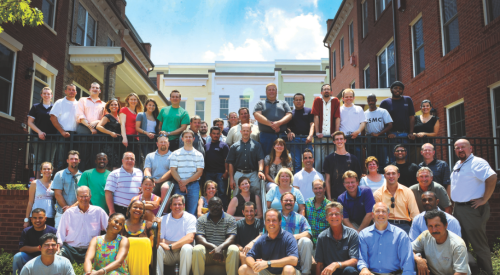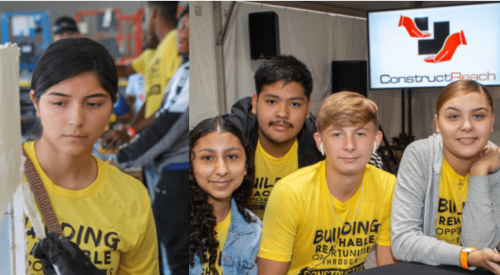An employee leaving a company is like a stone thrown in a still pond: ripples of disruption spread through the organization, creating unbalance. In any business, this unbalance can be expensive.
Turnover can cost a builder in recruiting and administrative fees, lack of attention to quality from employees on their way out, and slower productivity until new employees are up to speed. Damage to a builder's name and customer dissatisfaction, resulting from poor quality and delays, can be even more costly. These costs may never be recouped.
To minimize turnover, Pulte Homes has established a three-pronged process for recruiting talented people, getting them up to speed quickly, and keeping them happy. In doing so, the company has harnessed the power of its people. This in turn has enabled Pulte to deliver quality homes, be a clear leader in customer satisfaction, and sustain record profitability.
Hire a Talented CrewHiring and recruiting a large number of people can be a logistical nightmare. Pulte Homes hires between 2,500 and 3,000 people a year. But because of the processes they have in place, they're able to maintain a relatively small human resources department. Says Elaine Kramer, vice president of leadership development and training, "We feel that the best people to select, hire, train and evaluate employees are our own managers."
Recruiting is done by managers in each division. For entry-level positions, they focus on college recruits, because it's the easiest way to hire a large number of qualified people who have the aptitude to learn and the attitude to become part of the company culture. Another benefit to focusing on college recruits is lower turnover: 11-percent in the first year, compared with 29-percent companywide.
The division managers are given a template to follow and undertake a Talent Scout Training program that suggests ways to communicate with students, as well as strategies for presenting the Pulte organization. In addition, the program focuses on developing long-term partnerships with select colleges to generate good word of mouth among students. This eliminates the uncertainty of simply manning a booth at a career fair and hoping for a large turnout. Pulte also trains its managers on how to select and interview candidates.
The process is flexible enough to allow managers to incorporate their own ideas and practices. For example, some may arrange to teach a special course at a college, while other managers may have a career night with free pizza. The managers then share the most successful ideas with other divisions, which become best practices for everyone to implement.
Get Everyone on Board Before Setting SailTossing new hires into new positions with no training sets up both the employees and your business for failure and can quickly lead to turnover.
This first stage of the employee's relationship with your company is critical. A consistent process for initial orientation and training efforts not only helps employees learn their tasks and responsibilities, but should also start to indoctrinate them into your company culture.
For Pulte, whose culture is embedded in a Customer Delight program, this part of the process — indeed, from the very the first day on the job — is critical. "What people learn first, they remember most," says Kramer.
Every person entering an entry-level position at Pulte goes through an orientation process called On-Boarding. Two days of every month are devoted to On-Boarding, in which new employees start off their careers by spending time with the divisional leadership team, which presents the values and philosophy of the company and discusses how Pulte's "Homeowner for Life" initiative is a core part of the company's philosophy.
"This is critical," says, Erik Pekarski, national vice president of customer care relations. "Think of the different messages you give a new employee if you start by telling them how to build a house, rather than telling them about your culture, which involves teamwork, ownership, responsibility and Pulte's focus on customers."
Get Them Headed in the Right DirectionInitial orientation and training efforts are key for setting the right tone. But to ensure satisfaction and continued growth — two critical areas for minimizing turnover — you must also give new hires the specific tools they need to succeed.
Through a 12- to 16-week mentoring process, new hires learn their new jobs at their own pace. They also get a feel for how the company culture and relationships with customers and trades are integrated with their daily tasks. The mentors are trained through Pulte's Top Gun program, an initiative Pulte has had in place for a decade.
Within these first few months, different disciplines have certain training classes in common, but the recruits primarily undergo on-the-job training targeted to their individual needs. Construction employees, for example, may take online training courses from BuildIQ on water management best practices or job-site safety. The sales team may rotate through the construction department to learn how a home is built.
Train for a ReasonEvery training program should begin by aligning business objectives with individual needs. Before instituting any training program, part of Pulte's process is to review the company's major business objectives. Then, management seeks the input of the teams to learn what's working and what's not.
This approach accomplishes two things: First, it enables Pulte to leverage its training dollars by focusing on areas that most need improvement. Second, it gives employees a voice, empowering them to dictate their own success by identifying and working on areas for improvement.
One example of Pulte's success using this process is the company's market leadership in customer satisfaction. With Customer Delight as a major business objective, Pulte began analyzing customer surveys differently several years ago to focus on grouped, instead of individual, surveys. Corporate gave each division the process and methodology to do the same analysis.
From this analysis, customer relations emerged as an area to be improved. To meet this need, Pulte developed several new processes and training classes. The analysis and subsequent training delivered huge advances in the overall customer satisfaction score: from 77-percent prior to this initiative to 93-percent currently. Pulte was recently honored with several major awards in the area of customer satisfaction.
Cris Cash, national vice president of construction quality, says, "We were able to realize these accomplishments partly by ensuring new employees in every department understand the company's focus on customers, so they know how to help ensure customer satisfaction through their own jobs.
"For example, we teach new hires on our construction team that the house isn't the final result; it's the customer's response to the finished house that matters," Cash continues. "We also provide training tailored for construction-team members on best practices for communicating with customers. This helps them pave the way for delighting the customer during the construction process."
Ensure Smooth SailingThese days, a good base salary and bonus structure aren't enough. Employee satisfaction involves implementing initiatives aimed at recognition, growth and quality relationships. Pulte, for example, creates and maintains individual development plans for every employee. Annually, employees review their plans with their managers to discuss their strengths and weaknesses, and review their continued growth within Pulte. Each individual uses the standard forms and methodology to ensure consistency, but each employee and manager has the flexibility to carve out the employee's career path. "In this way, all employees know they have a future at Pulte in whatever they want to do," says Kramer.
Don't Make WavesFor a large homebuilder, creating and implementing a consistent but flexible process is critical for bringing in the right people, and giving them the tools they need to be successful.
For Pulte, implementing processes for hiring and growing employees has driven the company's success in key areas. First, by following a consistent process, each employee gets the knowledge he or she needs to build, sell and service quality homes. Through indoctrinating new hires into the company culture and training based on business objectives and individual needs, Pulte has excelled in customer satisfaction.
And, of course, delivering quality homes and satisfying the customer are key to maintaining profitability.












